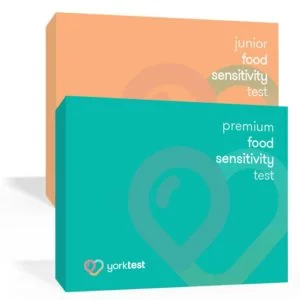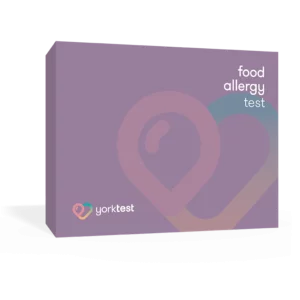Strawberries are one of the most popular fruits in the U.S. They can be bought both fresh and frozen in any major grocery store, and they’re a major domestic fruit crop with 98 percent of the country’s fresh strawberry production coming from California and Florida.
Although it’s not a common form of food allergy, individuals can be both mildly or extremely allergic to strawberries, and the onset can occur at any age. The severity of symptoms can vary widely and they can often be complicated with cross-reactive foods or intolerance symptoms. Those with strawberry allergies may also be allergic to other types of plant-derived foods — a condition known as latex-fruit syndrome.
As with any food allergy, there’s a lot to unpack. Below we discuss the nature of strawberry allergies, including common allergy symptoms, cross-reactive foods, testing options, and more.
How Common is Strawberry Allergy?
Experiencing an immuno-allergic reaction to strawberries indicates that you have a true allergy to the fruit and not just an intolerance. Rates of food allergy prevalence are somewhat common, affecting between 9 to 11 percent of adults and 6 to 8 percent of children.1 Unfortunately, there are limited data available about strawberry allergies and how common they are.
While there is no clear evidence indicating strawberry allergy rates and prevalence, there’s some research on children and a ton of studies on related allergies and cross-reactive foods. One study concentrated on children found that 3 to 4 percent of children aged 2 and under were allergic to strawberries, and the percentage dropped below 1 percent later in childhood and adulthood.2
In an interesting population-based survey study, an estimated 10.8 percent of adults surveyed reported having some kind of food allergy. Prior to being tested, 19 percent of the same population believed they had a food allergy, but only about half actually did after being tested.3 This misconception or misdiagnosis between allergy and intolerance highlights the importance of testing and confidently determining an allergic immune system response.
It’s also worth noting that the agricultural practices involved in strawberry farming and production can influence the potential allergenicity of the fruit. The results from a Polish study found that strawberries grown using organic farming practices were the safest because they contained lower levels of the common allergens Bet v1 and profilin when compared to strawberries grown in conventional and integrated pest management systems.4 In simple terms, organic strawberries may produce fewer allergy symptoms compared to conventional strawberries.
Bet v1 is a major allergen of birch pollen, which shares related IgE-binding proteins with other trees and plant foods. This is a universal source of many different food allergies. Similarly, profilin is a highly prolific allergen found across over 24 different plant pollens, including strawberries. These common protein allergens are what contribute to cross-reactivity found in other types of foods like pineapple, avocado, and banana, to name just a few.
In addition to birch pollen (Bet v1) cross-reactivity and being allergic or sensitive to some of the foods mentioned below, the risks of having a strawberry allergy can be higher in individuals who have asthma, eczema, or a family history of food allergies. These conditions, which are linked to the immune system, typically exacerbate food allergy symptoms.
Cross-Reactive Foods & Latex-Fruit Syndrome
There’s considerable overlap in individuals who are allergic to natural rubber latex while also displaying signs of hypersensitivity to particular plant foods, specifically certain types of fresh fruit. This condition, which is known as latex-fruit syndrome, is a form of allergen cross-reactivity that’s triggered when IgE antibodies recognize structurally similar protein molecules across related or phylogenetically similar foods and plant matter. (Proteins like Bet v1, Hev b 6.02, and Hev b 7).
Latex-fruit syndrome is a real condition that impacts 30 to 50 percent of those allergic to natural latex rubber.5 In addition to latex, which derives from a certain form of tree sap, those who are allergic to strawberries may also experience cross-reactive symptoms with these plant foods:
- Banana
- Bell pepper
- Chestnut
- Fig
- Kiwi
- Peach
- Potato
- Tomato
Less common foods that can have similar allergenic proteins include apricot, celery, mango, papaya, pineapple, and of course, strawberry. See more foods and latex-containing products to be cautious about.
Strawberries are also part of the Rosaceae family, which is known for extensive cross-reactivity with other fruits in the same family. These include foods like apples, pears, quinces, apricots, plums, cherries, peaches, raspberries, and rose buds. While Rosaceae fruit allergy is frequently associated with birch pollen (or Bet v1), it can also manifest without this specific pollen reactivity.
Symptoms of Strawberry Allergy
Strawberry allergy symptoms often manifest orally around the mouth and throat and particularly include itchy and swelling. Like other food allergy symptoms, an allergic reaction to strawberries can develop as quickly as a few minutes or after one or two hours post-exposure.
There are a wide range of symptoms that can be associated with strawberry allergy. These generally include:
- Skin rash
- Hives and eczema
- Itching and tingling mouth
- Throat tightness
- Itchy skin
- Wheezing and difficulty breathing
- Coughing and congestion
- Stomach distress
- Nausea and vomiting
- Diarrhea
- Dizziness and lightheadedness
Skin reactions around the mouth are some of the most common strawberry allergy symptoms. These prominent allergy symptoms are described in greater detail below.
Rash
Skin rash, particularly around the mouth, is one of the most common symptoms of strawberry allergies. The rash may be red, itchy, and can be spotty, developing anywhere on the body but most commonly on the face.
In addition to rash, eczema, and flushing of the skin, hives are another common food allergy symptom that can manifest. Hives are raised, itchy welts that can occur on the skin, inside the mouth, or the throat, thereby contributing to swollen airways.
Eczema, also known as atopic dermatitis, is much like a skin rash but a specific immune system disorder that causes the skin to become dry, cracked, and inflamed. It’s typically very itchy and harder to tolerate when it develops. It’s a common misconception that food allergies cause eczema. Rather, eczema will usually already be present, typically in babies and young children, and can the condition intensify with exposure to certain allergenic foods.
Swelling of the lips is another allergy symptom that often occurs when eating fresh strawberries, as allergenic proteins can spread all around the mouth. When this occurs, the lips can swell to the point where they are difficult to feel, move, or speak.
A tongue rash is another possible symptom of strawberry allergy. This condition usually develops with a rash around the inside and outside of the mouth, but maybe most prominent on the tongue itself. The rash is often itchy and red and can make it difficult to eat or drink.
In rare but extreme cases, strawberry allergy symptoms can trigger a life-threatening condition known as anaphylaxis, which is characterized by the closing of the throat and the inability to breathe. In situations like this, immediate medical attention is required.
Allergy sufferers who are susceptible to such extreme reactions should carry an epinephrine injection, commonly known as an EpiPen. This fast-acting medication can help decrease the body’s allergic reaction by relaxing the muscles of the airway to make it easier to breathe.
Sudden On-set & Later in Life Strawberry Allergy
A common question that often comes up across many food allergies is “can you suddenly develop an allergy to strawberries?”
The onset or stage of life in which fruit allergies emerge is not fully understood. Many individuals, particularly young children, can develop an allergy to strawberries if they do not get exposed to the food early in life. As a result, exposure to certain foods later in life can sometimes trigger an allergic reaction.
Likewise, adult-onset food allergies can occur if a person was never introduced to certain allergenic food during childhood. According to the American College of Allergy, Asthma, & Immunology, developing allergies to certain foods can occur at any age. It’s even possible to develop an allergy to foods that you’ve been consuming for years with no allergy signs or issues.
While adult-onset food allergies later in life are not as common as they are in children, it’s important to be mindful of symptoms when they arise and know how to distinguish and test a true allergy versus a strawberry intolerance or sensitivity.
Signs of Strawberry Intolerance
Symptomatically, strawberry allergies and intolerances or sensitivities are sometimes difficult to tell apart. However, the biological mechanisms triggering the reaction are very different.
Allergies are immune system responses that release histamines and IgE antibodies. Strawberry intolerance, on the other hand, does not release IgE proteins.
Strawberry intolerance symptoms can take from a few hours to a few days to develop, unlike allergies which can come about in a matter of minutes. Some of the most common signs of strawberry intolerance include:
- Upset stomach
- Bloating
- Diarrhea
- Headaches
- Skin rashes and inflammation
- Flushing of the face
- Swelling of face/lips
These intolerance symptoms will vary from person to person. The method of contact with strawberries will also influence the types of symptoms that occur. For example, symptoms like nausea, stomach distress, and diarrhea are more likely to occur if the sufferer has ingested strawberries.
Strawberry Allergy in Babies & Early Age Prevention
Strawberry allergies can be especially present in young children and infants. Per the study mentioned above, allergy rates range between 3 and 4 percent and taper below 1 percent after two years of age.6
Like adults, symptoms can range in severity from mild to extreme. The most common symptom of a strawberry allergy is itchy skin, which is often concentrated around the mouth, lips, and face. Congestion is another mild symptom that involves a runny nose, watering eyes, and wheezing.
More severe allergy symptoms in children are skin rashes or hives that are unbearably itchy and uncomfortable for several days. This can be accompanied by swelling of the mouth, lips, or face. If the inflammation grows to the point when wheezing evolves into shortness of breath and difficulty swallowing, the allergy is likely very extreme and should be addressed to avoid life-threatening symptoms.
While avoiding exposure to certain allergenic foods is a natural tendency for parents, there’s no evidence suggesting that minimizing exposure will reduce the chances of an allergy7.
More research is needed to draw a clear correlation but current science and allergy trends in children help underscore its validity. Food allergy in children is a subject of great concern as the incidence of food allergies has increased dramatically over the years, with rates near 3.9 percent in United States children, and growing.8
How to Test for Strawberry Allergy?
There are several ways to conduct a strawberry allergy test and validate a true allergic reaction versus having an intolerance. The most common include:
A skin test, or skin prick test, is one of the most common ways to test for strawberry allergy. With this test, a small amount of allergen is placed on the skin, and then the skin is lightly pricked with a needle. If you are allergic to strawberries, the skin will develop red, itchy bumps at the site of the prick within 15-20 minutes.
A Home-To-Laboratory Allergy Test Kit is one of the most reliable methods used to test for strawberry allergy. This test, which can be done by taking a very small blood sample, measures the level of antibodies in your blood that are specific to strawberries. If you have a high level of these antibodies, it is likely that you are allergic to strawberries.
If you suspect that you or your child may be allergic to strawberries, another way to pinpoint an allergy is to eliminate strawberries from your diet for a period of time and then reintroduce them. If you experience symptoms after eating strawberries, then you are likely allergic to them. The only problem with this testing technique is that it doesn’t fully rule out the possibility of a strawberry intolerance.
Final Takeaways
There are a few key takeaways to remember about strawberry allergies. First, they are relatively rare compared to other types of food allergies. Second, the symptoms can range from mild to severe, and they can easily be confused with intolerance symptoms. It’s important to be aware of your own body’s reaction to strawberries and get tested to pinpoint a true allergy. And finally, if you do have a strawberry allergy, it’s important to be conscious of cross-reactive foods that are common with latex-fruit allergy and other fruits of the same family.
If you think you might have a strawberry allergy, the best thing to do is to see an allergist or physician as well as get tested by taking a food allergy test. If you think it might be an intolerance or sensitivity you can opt for an at-home food sensitivity test or consult one of those professionals who can perform a test to confirm whether or not you are allergic to strawberries. If you are allergic, they can also help you develop a plan to avoid strawberries and manage your symptoms.
References
1. Gupta RS, Warren CM, Smith BM, Jiang J, Blumenstock JA, Davis MM, Schleimer RP, Nadeau KC. Prevalence and Severity of Food Allergies Among US Adults. JAMA Netw Open. 2019 Jan 4;2(1):e185630. doi: 10.1001/jamanetworkopen.2018.5630. PMID: 30646188; PMCID: PMC6324316..
2,6. Bajraktarevic A, Trninic S, Penava S, Mahinic A, Begovic B, Selmovic A, Kurtagic S, Frankic T, Gutic J, Hujic A, Sporisevic L. Prevalence of strawberry allergy in Bosnian children and management. Clin Transl Allergy. 2011 Aug 12;1(Suppl 1):P45. doi: 10.1186/2045-7022-1-S1-P45. PMCID: PMC3354175.
4. Aninowski M, Kazimierczak R, Hallmann E, Rachtan-Janicka J, Fijoł-Adach E, Feledyn-Szewczyk B, Majak I, Leszczyńska J. Evaluation of the Potential Allergenicity of Strawberries in Response to Different Farming Practices. Metabolites. 2020 Mar 12;10(3):102. doi: 10.3390/metabo10030102. PMID: 32178284; PMCID: PMC7143540.
5,6. Wagner, S, and H Breiteneder. “The latex-fruit syndrome.†Biochemical Society transactions vol. 30,Pt 6 (2002): 935-40. doi:10.1042/bst0300935
7. Chin B, Chan ES, Goldman RD. Early exposure to food and food allergy in children. Can Fam Physician. 2014 Apr;60(4):338-9. PMID: 24733323; PMCID: PMC4046529.
8. Branum, Amy M, and Susan L Lukacs. “Food allergy among children in the United States.†Pediatrics vol. 124,6 (2009): 1549-55. doi:10.1542/peds.2009-1210











